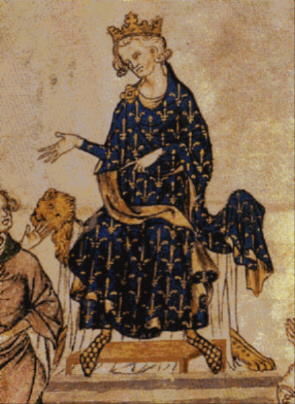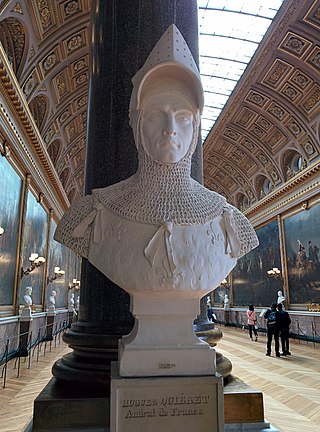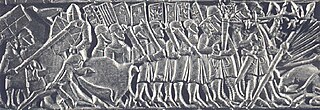
Philip VI, called the Fortunate or the Catholic and of Valois, was the first king of France from the House of Valois, reigning from 1328 until his death in 1350.

The Battle of Sluys, also called the Battle of l'Écluse, was a naval battle fought on 24 June 1340 between England and France. It took place in the roadstead of the port of Sluys, on a since silted-up inlet between Zeeland and West Flanders. The English fleet of 120–150 ships was led by Edward III of England and the 230-strong French fleet by the Breton knight Hugues Quiéret, Admiral of France, and Nicolas Béhuchet, Constable of France. The battle was one of the opening engagements of the Hundred Years' War.

51°15′N03°16′E

The first phase of the Hundred Years' War between France and England lasted from 1337 to 1360. It is sometimes referred to as the Edwardian War because it was initiated by King Edward III of England, who claimed the French throne in defiance of King Philip VI of France. The dynastic conflict was caused by disputes over the French feudal sovereignty over Aquitaine and the English claims over the French royal title. The Kingdom of England and its allies dominated this phase of the war.


The Battle of Blanchetaque was fought on 24 August 1346 between an English army under King Edward III and a French force commanded by Godemar du Fay. The battle was part of the Crécy campaign, which took place during the early stages of the Hundred Years' War. After landing in the Cotentin Peninsula on 12 July, the English army had burnt a path of destruction through some of the richest lands in France to within 20 miles (32 km) of Paris, sacking a number of towns on the way. The English then marched north, hoping to link up with an allied Flemish army which had invaded from Flanders. They were outmanoeuvred by the French king, Philip VI, who garrisoned all of the bridges and fords over the River Somme and followed the English with his own field army. The area had previously been stripped of food stocks by the French, and the English were essentially trapped.
The English Channel naval campaign of the years 1338 and 1339 saw a protracted series of raids conducted by the nascent French navy and numerous private raiders and pirates against English towns, shipping and islands in the English Channel, which caused widespread panic, damage and financial loss to the region and prompted a serious readjustment of English finances during the early stages of the Hundred Years' War. This period was then followed by a French disaster caused by over-confidence and a reversing of roles which had a major effect on the English successes of the next two decades; this result was by no means assured until late 1339 and had the French fought a little longer they might have ended the war before it had really begun.

The Battle of Saint-Omer, fought on 26 July 1340, was a major engagement in the early stages of the Hundred Years' War, during Edward III's 1340 summer campaign against France launched from Flanders. The campaign was initiated in the aftermath of the English naval victory at the Battle of Sluys but was far less successful than Edward had hoped. At Saint-Omer, the heavily-outnumbered French men-at-arms, tasked with defending the city and awaiting reinforcements, unexpectedly defeated the Anglo-Flemish forces on their own. The allies suffered heavy losses and the French captured their camp intact, taking many warhorses, draft animals and carts, all the tents, huge quantities of supplies and most of the Flemish standards. Edward's campaign of 1340 had begun badly. On the bright side, the loss of several thousand men was bearable, as the survivors, which included most of the precious English longbowmen, eventually rejoined him at Tournai. The defeat had serious strategic consequences. It exposed southern Flanders to the wrath of Philip VI and enabled the French to concentrate their forces against the main army of the coalition in the siege of Tournai.
The battle of Brest, sometimes called the battle of the River Penfeld, was an action in 1342 between an English squadron of converted merchant ships and that of a mercenary galley force from Genoa fighting for the Franco-Breton faction of Charles of Blois during the Breton War of Succession, a side conflict of the Hundred Years War.
Events from the 1330s in England.

Hugues Quiéret was a French nobleman, admiral and military commander. He was a knight, lord of Tours-en-Vimeu and of Hamicourt, both in Picardy. Before becoming an admiral, he was an advisor, Chamberlain, Grand Master of France, then the seneschal of Beaucaire and Nimes from 1325 to 1332.

The battle of Zierikzee was a naval battle between a Flemish fleet and an allied Franco-Hollandic fleet which took place on 10 and 11 August 1304. The battle, fought near the town of Zierikzee, ended in a Franco-Dutch victory. The battle is part of a larger conflict between the Count of Flanders and his French feudal lord, King Philip IV of France (1296–1305).

The siege of Tournai occurred during the Edwardian phase of the Hundred Years' War. The siege began when a coalition of England, Flanders, Hainaut, Brabant and the Holy Roman Empire under the command of King Edward III of England besieged the French city of Tournai. This siege would end in the Truce of Espléchin, marking the end of the Tournaisis campaign of 1340.

The Franco-Flemish War was a conflict between the Kingdom of France and the County of Flanders between 1297 and 1305.
The Truce of Espléchin (1340) was a truce between the English and French crowns during the early phases of the Hundred Years' War.
John Crabbe was a Flemish merchant, pirate and soldier who was active for around 35 years of his life. He defended Berwick Castle for the Scots against English forces in 1318, but after being captured by the English in 1332 he assisted the English when they again besieged Berwick in 1333, and became a loyal servant of Edward III, for whom he also fought at the Battle of Sluys in 1340.

The siege of Sluis (1604), also known as the Sluis campaign or the Battle of the Oostburg Line, was a series of military actions that took place during the Eighty Years' War and the Anglo–Spanish War from 19 May to 19 August 1604. A States and English army under Prince Maurice of Orange and Horace Vere respectively crossed the Scheldt estuary and advanced on land taking Cadzand, Aardenburg, and IJzendijke in the Spanish Netherlands. This soon led to the culmination of the siege of the Spanish-held inland port of Sluis.
The Battle of Margate, also known as the Battle of Cadzand, was a naval battle that took place 24–25 March 1387 during the Caroline War phase of the Hundred Years' War between an English fleet and a Franco-Castilian-Flemish wine fleet.
The Thiérache campaign, also known as the chevauchée of Edward III of 1339 was the march from Valenciennes, Hainault across Cambrésis, Picardy and Thiérache in northern France by an English army with Flemish, Hainault and Holy Roman Empire allies. It began on 20 September 1339, resulting in the siege of Cambrai and ended with the withdrawal of the English forces on 24 October, 1339, into Brabant. The English army was led by King Edward III, and the French by King Philip VI. It was a campaign during the Hundred Years' War.

The years 1599–1609 constituted a phase of in the Eighty Years' War between the Spanish Empire and the emerging Dutch Republic. It followed the Ten Years (1588–1598) that saw significant conquests by the Dutch States Army under the leadership of stadtholders Maurice of Nassau and William Louis of Nassau-Dillenburg, and ended with the conclusion of the Twelve Years' Truce (1609–1621) on 9 April 1609. The 1599–1609 period was generally marked by a stalemate; the well-known Battle of Nieuwpoort (1600) brought the Dutch a tactical victory without long-term gain, while Spanish conquests in the Siege of Ostend (1601–1604) and Spinola's 1605–1606 campaign were effectively balanced out by the Dutch naval triumph in the Battle of Gibraltar (1607) and the Spanish state bankruptcy that same year. Financial troubles were amongst the primary motives that prompted the Dutch, and even more so the Spanish, to head to the negotiating table for a ceasefire.












